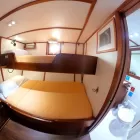Only 30,000-100,000 years old Fernandina is the youngest island of the Archipelago. This immature shield volcano is less than an instant in the geological time scale. Not even your wildest imagination can give you a better setting to experience the start of life on an island. The whole Island is covered with hostile worthless lava. However, at Punta Espinoza, the shoreline is teeming with life. Reptiles, birds, and mammals all coexist, singing and sexing. It is a living museum with piles of marine iguanas, playful sea lions, hard-working flightless cormorants, dwarf penguins, busy Sally light-foot crabs, and much more. Don’t forget to look around because Galapagos Hawk is always on the hunt. The site is a true cradle of evolution. Snorkeling with turtles, iguanas, cormorants and plenty of fish is the best way to refresh after the lava walk.
The hotspot under the Galapagos generates intense volcanic activity. The west islands are the youngest and most active of the Archipelago. Located in the center of Isabela, Alcedo Volcano is a reminder of how volatile these Islands are. On the west shoreline of Alcedo lays Urbina Bay. The landmass of the inlet was uplifted in 1954. More than ¾ of a mile of shoreline was created, and many coral reef extensions were exposed to air as the upheaval rose the seabed. The brand new land became a perfect nesting terrain for the most beautiful land dragon. The land iguanas of Isabela are the largest in the Galapagos and in Urbina the colorful population offers a great example of their growing potential. The impressive yellow, orange/brown iguanas roam the lowlands looking for flowers, fruits, leaves, and shoots of their favorite plants. Also, when the rains arrive is possible to see giant tortoises sharing the land with the other primitive-looking reptile. Urbina is a miniature reminder of a Jurassic time.
















